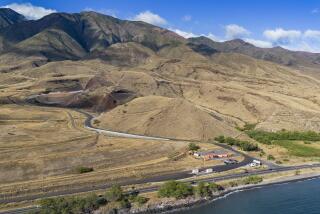A Dying Town at a Crossroads
LAST CHANCE, Colo. — The road east to this dying ranch town of 18 people passes the endless subdivisions of the swelling Denver metropolitan area. Then the interstate turns, and it’s almost all rolling prairie.
That empty space is what enticed various companies to buy up the land surrounding Last Chance and use it to dump Denver’s sewage and hazardous waste. Now one of those dumps -- a facility that residents battled for years -- wants permission to accept radioactive waste from inside and outside the state.
The ranchers and farmers who have watched their town slowly depopulate are mobilizing for what they see as Last Chance’s last stand.
“If we become a dumping area for the whole United States, we’re done for,” said Pam Whelden, 61, a cattle rancher whose husband’s family has owned the land for nearly a century. “Leroy’s parents homesteaded this place almost 100 years ago, and now we’re thinking, Do we want to stay here?”
The town is centered on a stop sign at the junction of two highways, U.S. 36 and Colorado 71, about 70 miles outside Denver. Its name comes from its reputation as the last chance to buy gas before continuing east to Kansas.
Problem is, the two gas stations at the intersection have long closed. So has the one restaurant -- a hamburger and ice cream stand whose owner last year concluded he could no longer put up with the years-long drought that has ravaged the region. The only inhabited building is the local Methodist church, whose minister, James Calhoun, lives in a house next door.
“I don’t have to go to a university and take a course in rural sociology,” Calhoun said. “I’m seeing it happen all around me.”
The ranchers’ children have mostly left for urban areas, seeking higher-paying jobs that are easier than chasing cattle and hauling water and hay. Like many high plains communities, all that’s left is the older ranchers and farmers who hang onto their slowly fading way of life.
The last thing Last Chance needs, Calhoun said, is radioactive waste.
“What we want here is some symbols of community and economic development,” Calhoun said, “and what we’re getting here is just what we don’t want.”
Clean Harbors Inc., based in Massachusetts, has asked Colorado to allow it to store low-grade radioactive waste at the 250-acre hazardous waste facility, and state officials have indicated that they’ll approve the request soon.
Company officials have said they will not store waste from nuclear power plants or other strong forms of radiation, but will use the facility to house natural-occurring radiation from the water systems that serve Denver and its suburbs. They also want to store old uranium mine tailings and other radioactive materials that were used to line Denver’s streets in the early 20th century but now must be moved.
“It’s a good fit,” said Phillip Retallick, a Clean Harbors senior vice president. “It’s sparsely populated, and the geology is perfect for this.” He said the 4,000 feet of solid shale beneath the landfill would prevent any radioactive matter from escaping.
To the ranchers struggling to hang on, though, the idea of taking more of the waste from the booming suburbs is an insult.
“It’s a rural versus urban problem,” said Gerald Schreiber, another local cattle rancher. “They want all the growth, all the good things, and we get all the ... sewage.”
Or as Whelden put it: “It’s an invasion. It’s the same as you and I driving to Denver and digging a hole and setting up an outhouse.”
That’s how Whelden felt in 1983, when Browning-Ferris Industries bought 1,200 acres of land south of her ranch. Before she and her neighbors knew it, the company had applied for a permit to build a hazardous waste storage facility covering 250 of those acres.
Last Chance’s ranchers teamed up with surrounding farmers and -- through bake sales and a tractor raffle -- raised $250,000 to fight the landfill. They joined up with unlikely allies.
Whelden remembers Greenpeace activists accompanying them on one lobbying trip to the state Capitol: They dressed in “worm-like” costumes and dumped sludge on the ground to symbolize toxic waste.
It was all for naught. Adams County granted the permit to Browning-Ferris. The ranchers sued and got some concessions but could not stop the project.
The permit, however, expressly forbade storage of radioactive waste. Over the decades, ownership of the site has changed hands five times. It now resides with Clean Harbors, which says it does not understand why the new, low-grade radioactive waste is such an issue. “The waste that we’re anticipating taking is less toxic than the hazardous waste we’ve been taking there for years,” Retallick said.
This time, Adams County is alongside the ranchers in objecting to the new waste, saying it has long wanted to keep radioactive material out of Last Chance.
“We’ve seen nothing that would cause us to change the original conditions we’ve imposed,” said Howard Kenison, a lawyer hired by the county to fight the proposal.
Residents say they are glad for the official help -- they don’t have the fight in them to go up against corporate America alone. “We hate to think we’d have to go into the community again to raise money,” Whelden said. “It’s kind of a depressed economy right now.”
The ranchers are taking a long view, though. Schreiber imagines that in 50 years scientists will conclude that waste once considered safe to store near inhabited areas will need to be moved -- again.
“And they’re going to say, ‘Those dummies, why did they let this happen?’ ”
More to Read
Sign up for Essential California
The most important California stories and recommendations in your inbox every morning.
You may occasionally receive promotional content from the Los Angeles Times.










